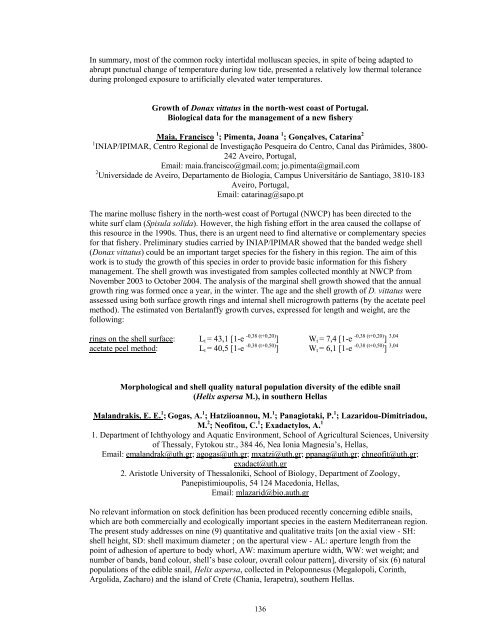World Congress of Malacology Antwerp ... - Unitas Malacologica
World Congress of Malacology Antwerp ... - Unitas Malacologica
World Congress of Malacology Antwerp ... - Unitas Malacologica
Create successful ePaper yourself
Turn your PDF publications into a flip-book with our unique Google optimized e-Paper software.
In summary, most <strong>of</strong> the common rocky intertidal molluscan species, in spite <strong>of</strong> being adapted to<br />
abrupt punctual change <strong>of</strong> temperature during low tide, presented a relatively low thermal tolerance<br />
during prolonged exposure to artificially elevated water temperatures.<br />
Growth <strong>of</strong> Donax vittatus in the north-west coast <strong>of</strong> Portugal.<br />
Biological data for the management <strong>of</strong> a new fishery<br />
Maia, Francisco 1 ; Pimenta, Joana 1 ; Gonçalves, Catarina 2<br />
1 INIAP/IPIMAR, Centro Regional de Investigação Pesqueira do Centro, Canal das Pirâmides, 3800-<br />
242 Aveiro, Portugal,<br />
Email: maia.francisco@gmail.com; jo.pimenta@gmail.com<br />
2 Universidade de Aveiro, Departamento de Biologia, Campus Universitário de Santiago, 3810-183<br />
Aveiro, Portugal,<br />
Email: catarinag@sapo.pt<br />
The marine mollusc fishery in the north-west coast <strong>of</strong> Portugal (NWCP) has been directed to the<br />
white surf clam (Spisula solida). However, the high fishing effort in the area caused the collapse <strong>of</strong><br />
this resource in the 1990s. Thus, there is an urgent need to find alternative or complementary species<br />
for that fishery. Preliminary studies carried by INIAP/IPIMAR showed that the banded wedge shell<br />
(Donax vittatus) could be an important target species for the fishery in this region. The aim <strong>of</strong> this<br />
work is to study the growth <strong>of</strong> this species in order to provide basic information for this fishery<br />
management. The shell growth was investigated from samples collected monthly at NWCP from<br />
November 2003 to October 2004. The analysis <strong>of</strong> the marginal shell growth showed that the annual<br />
growth ring was formed once a year, in the winter. The age and the shell growth <strong>of</strong> D. vittatus were<br />
assessed using both surface growth rings and internal shell microgrowth patterns (by the acetate peel<br />
method). The estimated von Bertalanffy growth curves, expressed for length and weight, are the<br />
following:<br />
rings on the shell surface: Lt = 43,1 [1-e -0,38 (t+0,20) ] Wt = 7,4 [1-e -0,38 (t+0,20) ] 3,04<br />
acetate peel method: Lt = 40,5 [1-e -0,38 (t+0,50) ] Wt = 6,1 [1-e -0,38 (t+0,50) ] 3,04<br />
Morphological and shell quality natural population diversity <strong>of</strong> the edible snail<br />
(Helix aspersa M.), in southern Hellas<br />
Malandrakis, Ε. Ε. 1 ; Gogas, A. 1 ; Hatziioannou, Μ. 1 ; Panagiotaki, P. 1 ; Lazaridou-Dimitriadou,<br />
Μ. 2 ; Ne<strong>of</strong>itou, C. 1 ; Exadactylos, A. 1<br />
1. Department <strong>of</strong> Ichthyology and Aquatic Environment, School <strong>of</strong> Agricultural Sciences, University<br />
<strong>of</strong> Thessaly, Fytokou str., 384 46, Nea Ionia Magnesia’s, Hellas,<br />
Email: emalandrak@uth.gr; agogas@uth.gr; mxatzi@uth.gr; ppanag@uth.gr; chne<strong>of</strong>it@uth.gr;<br />
exadact@uth.gr<br />
2. Aristotle University <strong>of</strong> Thessaloniki, School <strong>of</strong> Biology, Department <strong>of</strong> Zoology,<br />
Panepistimioupolis, 54 124 Macedonia, Hellas,<br />
Email: mlazarid@bio.auth.gr<br />
No relevant information on stock definition has been produced recently concerning edible snails,<br />
which are both commercially and ecologically important species in the eastern Mediterranean region.<br />
The present study addresses on nine (9) quantitative and qualitative traits [on the axial view - SH:<br />
shell height, SD: shell maximum diameter ; on the apertural view - AL: aperture length from the<br />
point <strong>of</strong> adhesion <strong>of</strong> aperture to body whorl, AW: maximum aperture width, WW: wet weight; and<br />
number <strong>of</strong> bands, band colour, shell’s base colour, overall colour pattern], diversity <strong>of</strong> six (6) natural<br />
populations <strong>of</strong> the edible snail, Helix aspersa, collected in Peloponnesus (Megalopoli, Corinth,<br />
Argolida, Zacharo) and the island <strong>of</strong> Crete (Chania, Ierapetra), southern Hellas.<br />
136



